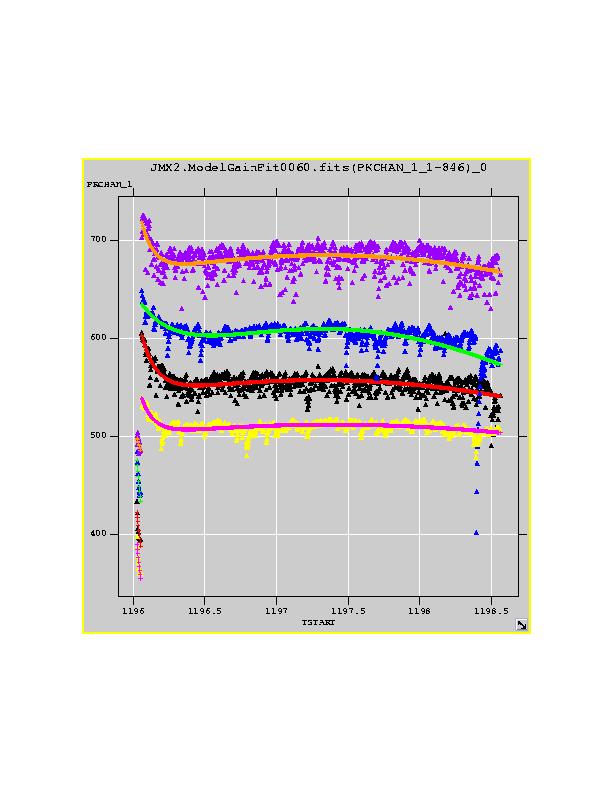
Gain glitches occur when an energetic cosmic ray particle hits the microstrip plate within one of the four calibration spectrum collection areas. The particle charges the plate so that the gain in the immediate area of the impact drops dramatically. It can take an hour or more for the gain in this area to recover (i.e. for the charge to disperse).

The biggest glitch so far seen during the mission occurred on JEM-X2 during revolution 60 on the 3rd calibration source (Fe: blue/green). In this case the position of the Cadmium calibration line dropped from PHA=550 to PHA=350, a drop of about 40% (the figure shows the source 3 position plus 50). The sign of a true glitch is a sudden drop in gain followed by a slower recovery that approaches the pre-glitch gain assymptotically.
Glitches are very localized. Though it may sometimes appear that two sources have glitches together, these invariably turn out to have happened several minutes apart when studied in detail. This is the case for revolution 60, where there is also apparently some simultaneous glitch activity on source 2 (yellow/pink). Since glitches are very localized it would be wrong to include this sudden drop in gain seen at a single point on the plate (a calibration area) in the gain calibration of the entire plate. Therefore the software is designed to smooth out sudden drops in gain where these occur on only one or two sources at a time.
The smoothing for revolution 60 has worked fine so that the smooth gain correction factors that are actually applied to the science events do not include this sudden, localized drop.
Currently, we have no idea of the physical extent of areas affected by individual glitches, but we do know that just as with the calibration areas, they crop up all over the plate at random times with a large distribution of sizes. There is no way that these random transient gain changes all over the microstrip plate can be tracked, which means that the overall effect of glitches is a degradation of the energy resolution of the JEM-X units. We can expect this glitch-induced energy resolution degradation to increase as we approach solar minimum in 2006 and experience an increase in cosmic ray activity. We might also expect the plates' sensitivity to glitches to increase as the plates age.
It is also interesting to note that the different calibration areas have somewhat different glitch characteristics. Source 2 on JEM-X1, for example has a tendancy to cascades of smaller glitches, whereas sources 1 and 3 seem to experience larger single glitches. These differences presumably reflect the slightly different conductivity properties in the plate at different places and we can be expect similar differences in behaviour to occur all over the plate.
Revolutions 425 and 426 were notable for containing strong glitches on different sources that appeared to be simultaneous, and raised the spectre of spatially extended glitches. Happily, a close look at the timing of these glitches showed them to be nothing but the statistical behaviour of random events: detail425, detail426.
Occasionally a broad dip is seen in a source's gain, but this too can usually be ascribed to glitch activity, where glitches follow quickly one after the other so that the gain never gets a chance to recover, leading to a prolonged drop in gain in the calibration area. A good example of this is revolution 145. Not surprisingly, this prime example of a glitch cascade occurs on source 2.
CAO 24/4/2006